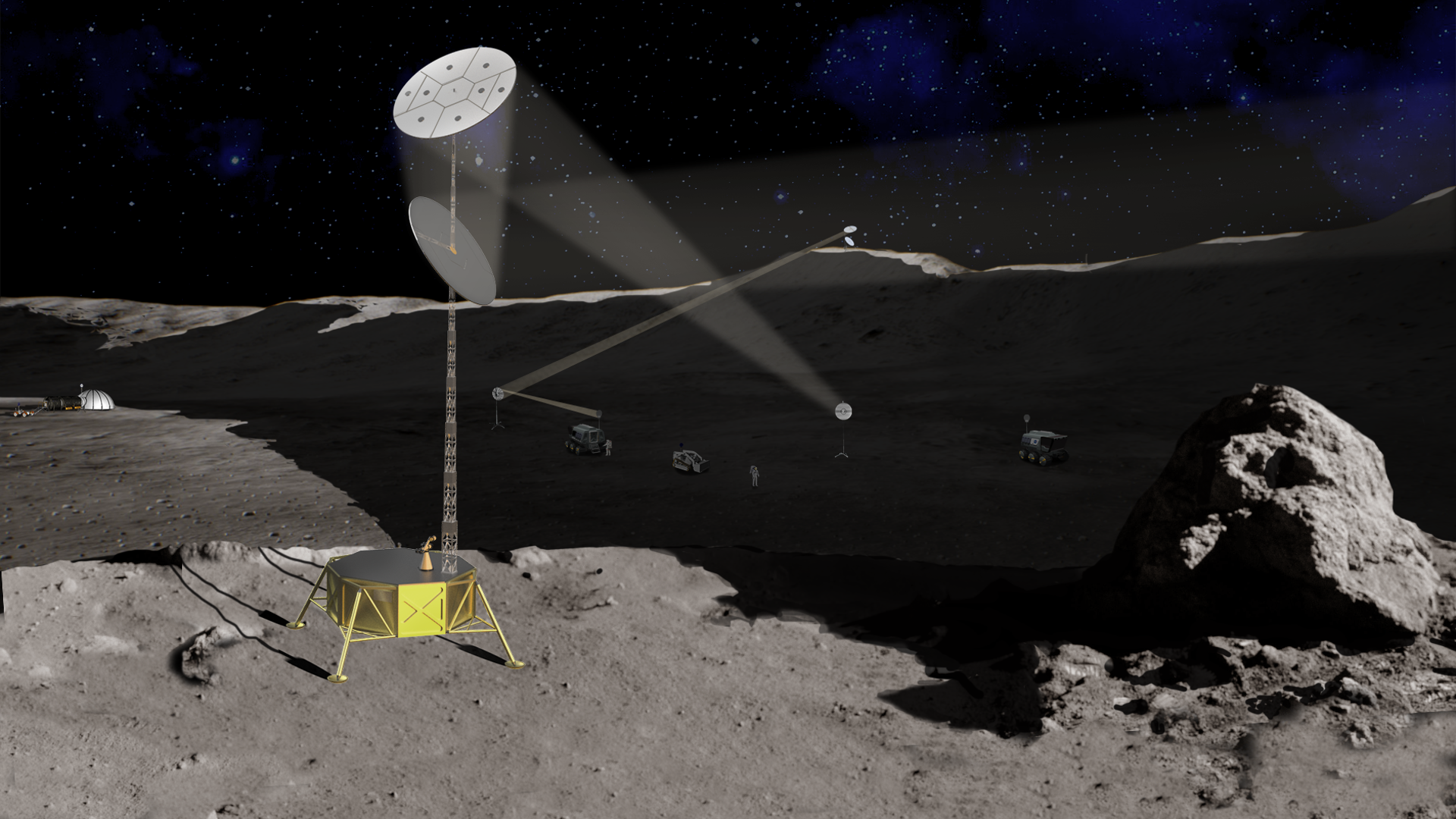Robotic 'Light Bender' on the moon could help Artemis astronauts keep the lights on
The Light Bender robotics project from space technology company Maxar will autonomously redirect sunlight to power solar panels in dark regions of the lunar surface.

A new undertaking from space technology company Maxar will use mirrors to autonomously track and reflect sunlight to supply energy to solar-powered equipment operating in the shadows of the moon's cliffs and craters.
NASA has set the goal to land astronauts near the moon's south pole by 2025 as a part of the agency's Artemis program. The moon's south pole is rich in resources such as water ice, but also experiences long periods of little to no sunlight. These conditions make energy production difficult, leaving few options to recharge batteries and maintain life-support, especially when using solar power.
A new Maxar project known as Light Bender aims to remedy that by using autonomous mirrors that will automatically reflect light towards essential equipment that Artemis astronauts might carry with them into permanently shadowed regions on the moon's surface.
Related: NASA's Artemis program: Everything you need to know
"Part of what we're doing is conceptually simple, reflecting sunlight to a solar panel located in the dark," said Maxar Chief Robotics Architect and lead for Light Bender Sean Dougherty in a Maxar statement. "Where it gets complex is doing that without humans involved. We're leveraging investments in autonomy to study how NASA can use robots to assemble and deploy a set of reflectors that keep sunlight focused on a solar panel operating in the shadows. It's never been done before."
Light Bender works by hoisting two 33-foot (10-meter) reflectors up a 65-foot (20-meter) telescoping mast. One mirror autonomously tracks the sun and reflects that light to the second mirror, which then reflects those rays towards the intended solar panels.
The Light Bender project is a collaboration between Maxar and NASA's Langley Research Center, and is scheduled for its first terrestrial demonstration in 2025. The company was awarded the contract in May 2023, under NASA's Announcement of Collaboration Opportunity Program. For their part, NASA's team is responsible for Light Bender's structural design, and Maxar is taking the lead on the robotics — an aptitude for which the company has demonstrated in the past.
Get the Space.com Newsletter
Breaking space news, the latest updates on rocket launches, skywatching events and more!
Maxar was behind the robotic arm on NASA's Perseverance rover, and has extensive background with satellite manufacturing and on-orbit assembly technology development.
Given the size of Light Bender's mirrors, Maxar also intends to assemble them once in space. Dougherty says autonomous robotics will have a crucial role in establishing the infrastructure needed for long-term lunar exploration. "We don't currently have construction crews on the moon or Mars, so robots will have to step in. By using these technologies to build infrastructure, robotics increase human safety and reduce the amount of people it takes to accomplish missions."
Artemis 3 will be the program's first crewed mission to the lunar surface, and will target the moon's south pole. The mission is slated to reach the moon no sooner than 2025. Artemis 2, meanwhile, is scheduled to send a crew of four around the moon and back in November 2024.
Join our Space Forums to keep talking space on the latest missions, night sky and more! And if you have a news tip, correction or comment, let us know at: community@space.com.

Josh Dinner is the Staff Writer for Spaceflight at Space.com. He is a writer and photographer with a passion for science and space exploration, and has been working the space beat since 2016. Josh has covered the evolution of NASA's commercial spaceflight partnerships and crewed missions from the Space Coast, as well as NASA science missions and more. He also enjoys building 1:144-scale model rockets and human-flown spacecraft. Find some of Josh's launch photography on Instagram and his website, and follow him on X, where he mostly posts in haiku.
-
newtons_laws The concept of redirecting sunlight into dark areas has already been used on Earth! The Norwegian town of Rjukan sits in a deep valley and given its Northern latitude sits in shade for half of the year. High on the mountain opposite, 450 metres above the town, three large, solar-powered, computer-controlled mirrors steadily track the movement of the sun across the sky, reflecting its rays down on to the square and bathing it in bright sunlight. Rjukan – or at least, a small but vital part of Rjukan – is no longer stuck where the sun don't shine. https://www.theguardian.com/.../rjukan-sun-norway-town...Reply









